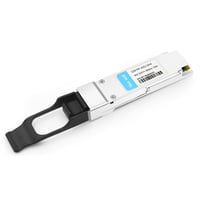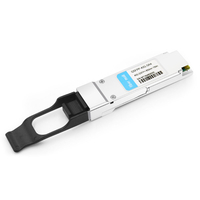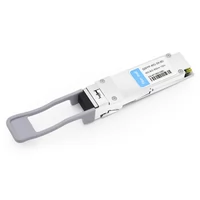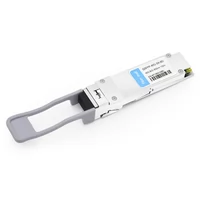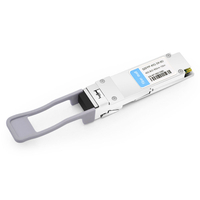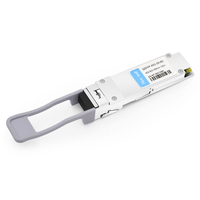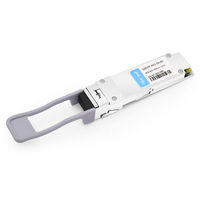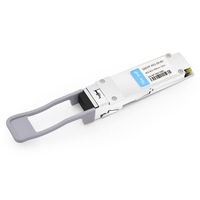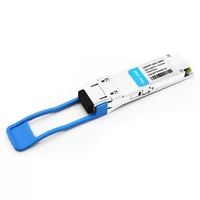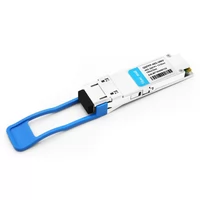There are four main QSFP+ optical modules for short-distance transmission in 40G networks: 40GBASE-SR4, 40GBASE-BiDi, 40GBASE-CSR4, and 40GBASE-UNIV, among which BiDi, SR4, and UNIV are typical.
40G QSFP BIDI SR Optical Transceiver Module: Two-way 20G Single Fiber Bi–directional
The 40G QSFP BIDI SR optical module uses two 20G channels to achieve 40G transmission. Using WDM technology, each transceiver channel can simultaneously transmit and receive optical signals from a multi-mode fiber at different wavelengths (commonly 850nm and 900nm). The QSFP-40G-SR-BD optical module for short-distance data transmission can transmit up to 100m when paired with an OM3 fiber jumper, and up to 150m when paired with an OM4 fiber jumper.
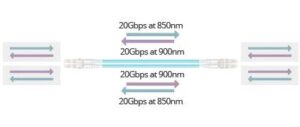
The 40G QSFP BIDI SR optical module can make full use of the duplex LC jumper in the existing 10G cabling system to quickly establish a 40G network. Compared with other traditional solutions, using the QSFP-40G-SR-BD optical module to realize a 40G network upgrade is more convenient and fast. Note that the 40G QSFP BIDI SR must be used in pairs.
| FiberMall P/N | QSFPP-40G-SR-BD | Vendor Name | FIBER MALL |
|---|---|---|---|
| Form Factor | QSFP+ | Max Data Rate | 40Gbps |
| Wavelength | 850nm, 900nm | Max Distance | 100m @ OM3 /150m @OM4 |
| Connector | Duplex LC | Transmitter Type | VCSEL 850nm |
| Cable Type | MMF | Receiver Type | PIN |
| TX Power | -4.0~+5.0dBm | Receiver Sensitivity | < -6.0dBm |
| Protocols | 40G Ethernet, IEEE802.3ba-2010, MSA Compliant | Operation Temperature | 0 to 70°C (32 to 158°F) |
40G QSFP SR4 Optical Transceiver Module: Four Channels of 10 Gbps Parallel Transmission
The 40GBASE-SR4 optical module (QSFP-40G-SR4 optical module) complies with IEEE 802.3BA 40GBASE-SR4 standard and adopts MPO/MTP interface. When used with OM3 optical fibers, the maximum transmission distance can reach 300m. The maximum transmission distance is 400m when the optical fiber is used with OM4.

The 40G QSFP SR4 optical module has four independent optical signal transmitting and receiving channels, each of which supports 10 Gbps data transmission. It is usually used with a 12-core MTP/MPO fiber jumper. Four cores are used for transmitting, four cores are used for receiving, and the four cores in the middle are idle. In addition, 4x10G transmission can be achieved by connecting an 8-core MTP-LC branch cable.
| FIBER MALL P/N | QSFPP-40G-SR4 | Vendor Name | FIBER MALL |
|---|---|---|---|
| Form Factor | QSFP+ | Max Data Rate | 40Gbps |
| Wavelength | 850nm | Max Distance | 100m @OM3 /150m @OM4 |
| Connector | MTP/MPO | Transmitter Type | VCSEL 850nm |
| Cable Type | MMF | Receiver Type | PIN |
| TX Power | -8~1.0dBm | Receiver Sensitivity | < -13dBm |
| Protocols | 40G Ethernet, Infiniband QDR, SATA/SAS3, IEEE 802.3ba, MSA Compliant | Operation Temperature | 0 to 70°C (32 to 158°F) |
40G UNIV Optical Transceiver Module: Four Channels Transmit at 10 Gbps Multiplexed
The QSFP-40G-UNIV optical module is a duplex LC interface optical module that complies with industry standards. It has four working wavelengths of 1270nm, 1290nm, 1310nm, and 1330nm, and four transmitting and receiving channels, each with a transmission rate of 10Gbps. During operation, the four transmitted optical signals of the 40G UNIV optical module will be coupled into one 40Gbps optical signal through the internal multiplexer for transmission on the duplex LC fiber jumper. In addition, a de-multiplexer is configured inside the optical module to split the coupled optical signals into four received signals.
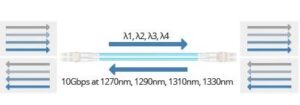
Different from the 40G QSFP SR4 and 40G QSFP BIDI SR, the 40G QSFP UNIV optical module can be used with both single-mode and multi-mode optical fibers. No devices on the network need to be replaced during single-mode replacement. The transmission distance on the OM3 multi-mode fiber is 100m, the transmission distance on the OM4 multi-mode fiber is 150m, and the transmission distance on the single-mode fiber is 500m to 2km.
| FiberMall P/N | QSFPP-40G-UNIV | Vendor Name | FIBER MALL |
|---|---|---|---|
| Form Factor | QSFP+ | Max Data Rate | 40Gbps |
| Wavelength | 1310nm | Max Distance | 2km on SMF / 150m on OM3 MMF |
| Connector | LC Duplex | Transmitter Type | 4 Lanes CWDM DFB |
| Cable Type | MMF/SMF | Receiver Type | PIN |
| TX Power | -7~2.3dBm | Receiver Sensitivity | < -10.5dBm |
| Protocols | 40G Ethernet, MSA Compliant | Operation Temperature | 0 to 70°C (32 to 158°F) |
Difference between 40G SR4, 40G BIDI, and 40G UNIV
| Transceiver Moudle | 40G SR4 | 40G BIDI | 40G UNIV |
|---|---|---|---|
| Connector | MTP/MPO | Duplex LC | Duplex LC |
| Cable Type | MMF | MMF | MMF/SMF |
| Wavelength | 850nm | 832nm-918nm | 1270nm,1290nm, 1310nm,1330nm |
| Transmission Distance | 150m@OM4 100m@OM3 | 150m@OM4 100m@OM3 | 150m@OM4 100m@OM3 2km@SMF |
| Whether 4 x 10 G links are supported | Yes | No | No |
10G Upgrade to 40G: How to Choose
When the network needs to be upgraded from 10G to 40G, whether to choose 40G SR4, 40G BIDI, or 40G UNIV can be discussed in two cases:
- In unstructured cabling systems, fiber jumpers are usually directly connected to devices. This mode is suitable for the connection between short-distance devices in data centers. Two 40G QSFP SR4 optical modules can be directly connected with a type-B polarity MTP jumper, and two 40G QSFP BIDI SR or 40G QSFP UNIV optical modules can also be directly connected with a duplex LC multi-mode jumper. Since existing 10G network connections usually use LC multi-mode fiber jumpers, it is obvious that when it comes to 10G to 40G upgrade, 40G QSFP BIDI SR and 40G QSFP UNIV optical modules can make full use of the existing 10G network cabling system and easily upgrade to 40G network, saving a lot of cabling costs.
- In the data center network layout, the structured cabling system is more flexible and can cover a wider range. Different from the unstructured cabling system, the structured cabling system needs to add some additional accessories, such as optical fiber distribution boxes. If the 40G QSFP SR4 optical module is used during the upgrade from a 10G network to a 40G network, replace the LC fiber jumper in the 10G network with the MTP jumper. The optical cable distribution box needs to be replaced with an MTP adapter panel, and connect the adapter panel with an MTP jumper. If two 40G QSFP BIDI SR or 40G QSFP UNIV optical modules are used, only the modules at both ends need to be replaced. The LC jumper and the corresponding optical distribution box can be reused without changing the existing 10G cabling pattern.
Summary
The 40G QSFP BIDI SR and 40G QSFP UNIV optical modules can upgrade from 10G to 40G without changing the existing 10G cabling infrastructure, with high flexibility and simplicity. The 40G QSFP SR4 optical module is widely used in 40G to 10G network transmission with 8 core MTP-LC fiber jumper. Among the three types of optical modules, the 40G QSFP UNIV is the most recommended one. The reasons are as follows: In the future, in 100G or even 400G networks, the transmission distance supported by OM3/OM4 multi-mode optical fibers are very limited and cannot meet most transmission requirements of high-rate data centers. Therefore, the sooner the data center cabling system is changed to single-mode cabling, the more cost will be saved by upgrading to 100G and 400G networks in the future. However, the 40G QSFP+ long-range optical module supporting single-mode transmission is very expensive and the deployment cost is high. The 40G QSFP UNIV single-mode optical transceiver supports transmission distances of up to 2 km, helping to reduce this cost.
Table of Contents
ToggleRelated Products:
-
 Cisco QSFP-40G-SR4 Compatible 40G QSFP+ SR4 850nm 150m MTP/MPO MMF DDM Transceiver Module
$25.00
Cisco QSFP-40G-SR4 Compatible 40G QSFP+ SR4 850nm 150m MTP/MPO MMF DDM Transceiver Module
$25.00
-
 Arista Networks QSFP-40G-SR4 Compatible 40G QSFP+ SR4 850nm 150m MTP/MPO MMF DDM Transceiver Module
$25.00
Arista Networks QSFP-40G-SR4 Compatible 40G QSFP+ SR4 850nm 150m MTP/MPO MMF DDM Transceiver Module
$25.00
-
 Cisco QSFP-40G-SR-BD Compatible 40G QSFP+ SR Bi-Directional 850nm/900nm 100m/150m Duplex LC MMF Transceiver Module
$249.00
Cisco QSFP-40G-SR-BD Compatible 40G QSFP+ SR Bi-Directional 850nm/900nm 100m/150m Duplex LC MMF Transceiver Module
$249.00
-
 Arista Networks QSFP-40G-SRBD Compatible 40G QSFP+ SR Bi-Directional 850nm/900nm 100m/150m Duplex LC MMF Transceiver Module
$249.00
Arista Networks QSFP-40G-SRBD Compatible 40G QSFP+ SR Bi-Directional 850nm/900nm 100m/150m Duplex LC MMF Transceiver Module
$249.00
-
 Dell QSFP-40G-BIDI Compatible 40G QSFP+ SR Bi-Directional 850nm/900nm 100m/150m Duplex LC MMF Transceiver Module
$249.00
Dell QSFP-40G-BIDI Compatible 40G QSFP+ SR Bi-Directional 850nm/900nm 100m/150m Duplex LC MMF Transceiver Module
$249.00
-
 Extreme 10329 Compatible 40G QSFP+ SR Bi-Directional 850nm/900nm 100m/150m Duplex LC MMF Transceiver Module
$249.00
Extreme 10329 Compatible 40G QSFP+ SR Bi-Directional 850nm/900nm 100m/150m Duplex LC MMF Transceiver Module
$249.00
-
 H3C QSFP-40G-BIDI-SR-MM850 Compatible 40G QSFP+ SR Bi-Directional 850nm/900nm 100m/150m Duplex LC MMF Transceiver Module
$249.00
H3C QSFP-40G-BIDI-SR-MM850 Compatible 40G QSFP+ SR Bi-Directional 850nm/900nm 100m/150m Duplex LC MMF Transceiver Module
$249.00
-
 Huawei QSFP-40G-SR-BD Compatible 40G QSFP+ SR Bi-Directional 850nm/900nm 100m/150m Duplex LC MMF Transceiver Module
$249.00
Huawei QSFP-40G-SR-BD Compatible 40G QSFP+ SR Bi-Directional 850nm/900nm 100m/150m Duplex LC MMF Transceiver Module
$249.00
-
 Cisco QSFP-40G-UNIV Compatible 40G QSFP+ UNIV 1310nm 150m/2km LC MMF/SMF DDM Transceiver Module
$149.00
Cisco QSFP-40G-UNIV Compatible 40G QSFP+ UNIV 1310nm 150m/2km LC MMF/SMF DDM Transceiver Module
$149.00
-
 Arista Networks QSFP-40G-UNIV Compatible 40G QSFP+ UNIV 1310nm 150m/2km LC MMF/SMF DDM Transceiver Module
$149.00
Arista Networks QSFP-40G-UNIV Compatible 40G QSFP+ UNIV 1310nm 150m/2km LC MMF/SMF DDM Transceiver Module
$149.00

